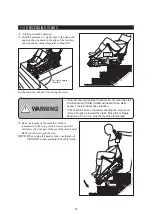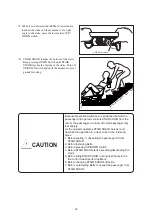
14
Place Stair Gauge between a nose and the next nose
to measure the pitch of the step.
If the pitch of the step is between the two holes at
both ends of Stair Gauge, the machine can be used.
If the pitch of the step is outside of the two holes,
the machine cannot be used because doing so could
be dangerous.
NOTE:
The distance between the two holes at both
ends of Stair Gauge is 340 mm.
m
Place Stair Gauge between the noses of the two
steps to measure the slope of the stairs.
If the indicating needle of Stair Gauge rests on a
point in the green range, the machine can be used.
If the needle points to a red zone, do not use the
machine because doing so could be dangerous.
n
Place Stair Gauge on an edge of a step to measure
the roundness of the step edge (nose).
Put the recess at the right end of Stair Gauge at the
edge of a step. If the edge is too round to be set into
the recess, do not use the machine because doing so
could be dangerous.
NOTE:
The radius of the recess on Stair Gauge is
9 mm (9 R).
After measurement, be sure to reset Stair Gauge to
its original position.
NOTE:
In case you have lost Stair Gauge, obtain
another gauge from your sales agent.
Stair Gauge
Hole
Stair Gauge
340 mm
Hole
Stair Gauge
Red Color Range
Green Color Range
Indicating Needle
9 mm or under
Stair Gauge
Recess
10 mm or over
Stair Gauge
Recess
Measure the stairs using Stair Gauge to determine if the
stairs can be used.
•
The height of a step is within the black line of Stair Gauge
(180 mm or under).
•
The pitch between the edges of the steps is within the
holes of Stair Gauge (340 mm or under).
•
The indicating needle points within the green zone of the
gauge (not exceeding 35 degrees).
•
The recess on Stair Gauge can take the nose of a step (9
R or under).
Never use the machine with stairs that do not satisfy the
above because doing so could be dangerous.
DANGER
















































